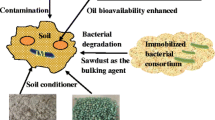Abstract
A two-stage, field-scale bioreactor system was used to determine the efficacy of bioremediation of creosote- and pentachlorophenol (PCP)-contaminated ground water at the abandoned American Creosote Works (ACW) site in Pensacola, Florida. In separate 15-day runs of the field-scale (454L) system, bioreactor performance in the presence of specially-selected microbial inoculants was compared to that observed using non-specific biomass. In the first run, Bioreactor #1 was amended with nutrients, surfactants and microorganisms (strains CRE 1–13) that were isolated from soil at ACW and selectively cultured for their ability to biodegrade monitored creosote constituents. After 4 days of organism acclimation and degradation of organic contaminants, the batch system was converted to a flow-through regime. Effluent was transferred to Bioreactor #2 where Pseudomonas paucimobilis strain EPA 505 and Pseudomonas sp. strain SR 3 were introduced. A second 15-day bioreactor run was conducted using indigenous bacteria and microorganisms from a waste water treatment facility that was designed to treat effluents containing PAHs and phenolics.
Bioreactor performance was evaluated by chemical analysis of feed water initially pumped into Bioreactor #1 and clarified effluent from Bioreactor #2. These materials were also tested for toxic/teratogenic responses with developing embryonic Menidia beryllina, with Microtox® 5-min EC50 tests, and with Ceriodaphnia dubia 48-h LC50 tests. Results obtained with specialty organisms in the first run of the field-scale bioreactor showed that, on average, 70.6% of polycyclic aromatic hydrocarbons (PAHs) and heterocycles were degraded. Only 36.9% of the pentachlorophenol (PCP) present was biodegraded, apparently because of low cell counts and incomplete induction of Pseudomonas sp. strain SR 3. A concomitant 67- to 74-fold decrease in toxicity was measured in Microtox® 5-min EC50 and Ceriodaphnia 48-h LC50 values, respectively. No reduction in toxicity/teratogenicity was measurable in tests with embryonic M. beryllina.
In the second 15-day run of the bioreactor, microorganisms from an industrial waste water treatment facility averaged 51.0% biodegradation of PAHs and heterocycles. Degradation of PCP was 81.0%, a value substantially higher than in the first run. An 87-fold reduction in toxicity was measured with the Microtox® 5-min EC50, but only a 2.9-fold reduction in acute toxicity was measured in the Ceriodaphnia 48-L LC50 test. In the second bioreactor run, samples taken from Bioreactors #1 and #2 indicated reduced embryo toxicity/teratogenicity. At the 1% test concentration most embryos developed normally and hatched. Larvae were also normal.
Similar content being viewed by others
References
American Public Health Association (1989) Standard methods for the examination of water and wastewater, Franson MAH (ed), 17th Edition. Washington, DC
Bedient PB, Rodgers AC, Bouvette TC, Tomson MB, Wang TH (1984) Groundwater quality at a creosote waste site. Groundwater 22:318–329
Elder JF, Dresler PV (1988) Accumulation and bioconcentration of polycyclic aromatic hydrocarbons in a nearshore estuarine environment near a Pensacola (Florida) creosote contamination site. Environ Pollut 49:117–132
Goerlitz DF, Troutman DE, Godsy EM, Franks BF (1985) Migration of wood-preserving chemicals in contaminated groundwater in a sand aquifer at Pensacola, Florida. Environ Sci Technol 19:955–961
HACH Water Analysis Handbook (1989) HACH Company, Loveland, CO
Lamar RT, Dietrich DM (1990) In situ depletion of pentachlorophenol from contaminated soil by Phanerochaete spp. Appl Environ Microbiol 56:3093–3100
Microbics Corporation (1988) How to run toxicity tests using the Microtox® Model 500. Microbics Corp, Carlsbad, CA
Middaugh DP, Mueller JG, Thomas RL, Lantz SE, Hemmer MJ, Brooks GT, Chapman PJ (1991) Detoxification of pentachlorophenol and creosote contaminated groundwater by physical extraction: Chemical and biological assessment. Arch Environ Contam Toxicol 21:233–244
Middaugh DP, Resnick SM, Lantz SE, Heard CS, Mueller JG (1993) Toxicological assessment of biodegraded pentachlorophenol: Microtox® and fish embryos. Arch Environ Contam Toxicol 24:165–172
Middaugh DP, Thomas RL, Lantz SE, Heard CS, Mueller JG (1994) Field-scale testing of a hyperfiltration unit for removal of creosote and pentachlorophenol from groundwater: Chemical and biological assessment. Arch Environ Contam and Toxicol 26:309–319
Mueller JG, Chapman PJ, Pritchard PH (1989) Action of fluoranthene-utilizing bacterial community on polycyclic aromatic hydrocarbon components of creosote. Appl Environ Microbiol 55:3085–3090
Mueller JG, Middaugh DP, Lantz SE, Chapman PJ (1991a) Biodegradation of creosote and pentachlorophenol in contaminated groundwater: Chemical and biological assessment. Appl Environ Microbiol 57:1277–1285
Mueller JG, Lantz SE, Blattmann BO, Chapman PJ (1991b) Bench-scale evaluation of alternative biological treatment processes for the remediation of pentachlorophenol- and creosote-contaminated materials: Slurry-phase bioremediation. Environ Sci Technol 25:1055–1061
Mueller JG, Lantz SE, Ross D, Colvin RJ, Middaugh DP, Pritchard PH (1993) Strategy using bioreactors and specially-selected microorganimss for bioremediation of ground water contaminated with creosote and pentachlorphenol. Environ Sci Technol 27:691–698
Pereira WE, Rostad CE, Garbarino JR, Hult MF (1983) Groundwater contamination by organic bases derived from coal-tar wastes. Environ Toxicol Chem 2:283–294
Resnick SM, Chapman PJ (1990) Abstr Annu Meet Am Soc Microbiol Q70, p 300
StatSoft Incorporated (1991) Complete statistical systems: Statistica version 3.0. StatSoft Inc, Tulsa, OK, 968 pp
U.S. Environmental Protection Agency (1986) Federal register. Part III. Creosote, pentachlorophenol and inorganic arsenicals; amendment of notice of intent to cancel registrations. Fed Reg 51 (7):1334–1348
Author information
Authors and Affiliations
Additional information
Contribution No. 889 of the Gulf Breeze Environmental Research Laboratory. Mention of trade name does not imply endorsement of commercial products by the U.S. Environmental Protection Agency.
Rights and permissions
About this article
Cite this article
Middaugh, D.P., Lantz, S.E., Heard, C.S. et al. Field-scale testing of a two-stage Bioreactor for removal of creosote and pentachlorophenol from ground water: Chemical and biological assessment. Arch. Environ. Contam. Toxicol. 26, 320–328 (1994). https://doi.org/10.1007/BF00203558
Received:
Revised:
Issue Date:
DOI: https://doi.org/10.1007/BF00203558




